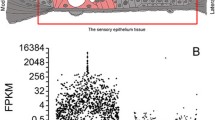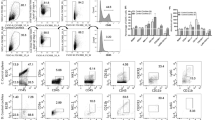Abstract
Otitis media is a common disease in childhood. In adults, the disease is relatively rare, but more frequently associated with complications. Possible reasons for this discrepancy are age-related differences in pathogen exposure, anatomy of the Eustachian tube and immune system. The objective of this study was to analyze the relationship between age and the mucosal immune system in the middle ear. It is hypothesized that genes involved in the middle ear immune system will change with age. A comprehensive assessment of these genetic differences using the techniques of complementary DNA has not been performed. Complementary DNA microarray technology was used to identify immune-related genes differentially expressed between the normal middle ear mucosa of young (10 days old) and adult rats (80 days old). Data were analyzed using tools of bioinformatics. A total of 260 age-related genes were identified, of which 51 genes were involved in the middle ear mucosal immune system. Genes related to the innate immune system, including alpha-defensin, calcium-binding proteins S100A9 and S100A8, were upregulated in young rats, whereas genes related to the adaptive immune system, including CD3 molecules, zeta-chain T-cell receptor-associated protein kinase and linker of activated T-cells, were upregulated in the adult. This study concludes that the normal middle ear immune system changes with age. Genes related to the innate immune system are upregulated in young rats, whereas genes related to the adaptive immune system are upregulated in adults.
Similar content being viewed by others
References
Rosenfeld RM, Kay D (2014) Natural history of untreated otitis media. In: Rosenfeld RM, Bluestone CD (eds) Evidence-based otitis media, 2nd edn. BC Decker, Hamilton, pp 180–198
Teele DW, Klein JO, Rosner B (1989) Epidemiology of otitis media during the first seven years of life in children in greater Boston: a prospective, cohort study. J Infect Dis 160:83–94
Fusunyan RD, Nanthakumar NN, Baldeon ME et al (2001) Evidence for an innate immune response in the immature human intestine: toll-like receptors on fetal enterocytes. Pediatr Res 49:589–593
MacDonald TT, Spencer J (1994) Ontogeny of the gut-associated lymphoid system in man. Acta Paediatr Suppl 83:3–5
Perkkio M, Savilahti E (1980) Time of appearance of immunoglobulin-containing cells in the mucosa of the neonatal intestine. Pediatr Res 14:953–955
Bridges RA, Condie RM, Zak SJ et al (1959) The morphologic basis of antibody formation development during the neonatal period. J Lab Clin Med 53:331–357
Harju K, Glumoff V, Hallman M (2001) Ontogeny of Toll-like receptors Tlr2 and Tlr4 in mice. Pediatr Res 49:81–83
Takemura T, Eishi Y (1985) Distribution of secretory component and immunoglobulins in the developing lung. Am Rev Respir Dis 131:125–130
Thrane PS, Rognum TO, Brandtzaeg P (1991) Ontogenesis of the secretory immune system and innate defence factors in human parotid glands. Clin Exp Immunol 86:342–348
Krishnan S, Craven M, Welliver RC et al (2003) Differences in participation of innate and adaptive immunity to respiratory syncytial virus in adults and neonates. J Infect Dis 188:433–439
Mogi G, Maeda S, Watanabe N (1980) The development of mucosal immunity in guinea pig middle ears. Int J Pediatr Otorhinolaryngol 1:331–349
Gentleman RC, Carey VJ, Bates DM et al (2004) Bioconductor: open software development for computational biology and bioinformatics. Genome Biol 5:R80
Dai M, Wang P, Boyd AD (2005) Evolving gene/transcript definitions significantly alter the interpretation of GeneChip data. Nucleic Acids Res 33:e175
Wu Z, Irizarry R, Gentleman R et al (2004) A model-based background adjustment for oligonucleotide expression arrays. J Am Stat Assoc 99:909–917
Calza S, Valentini D, Pawitan Y (2008) Normalization of oligonucleotide arrays based on the least-variant set of genes. BMC Bioinformatics 9:140
Calza S, Raffelsberger W, Ploner A (2007) Filtering genes to improve sensitivity in oligonucleotide microarray data analysis. Nucleic Acids Res 35:e102
Friis M, Martin-Bertelsen T, Friis-Hansen L et al (2011) Gene expression of the endolymphatic sac. Acta Otolaryngol 131:1257–1263
Nielsen M, Martin-Bertelsen T, Friis M et al (2014) Bone signaling in middle ear development: a genome-wide differential expression analysis. Anat Rec (Hoboken) 297:2349–2355
Sohnle PG, Collins-Lech C, Wiessner JH (1991) Antimicrobial activity of an abundant calcium-binding protein in the cytoplasm of human neutrophils. J Infect Dis 163:187–192
Nisapakultorn K, Ross KF, Herzberg MC (2001) Calprotectin expression inhibits bacterial binding to mucosal epithelial cells. Infect Immun 69:3692–3696
Cornish CJ, Devery JM, Poronnik P et al (1996) S100 protein CP-10 stimulates myeloid cell chemotaxis without activation. J Cell Physiol 166:427–437
Vogl T, Tenbrock K, Ludwig S et al (2007) Mrp8 and Mrp14 are endogenous activators of Toll-like receptor 4, promoting lethal, endotoxin-induced shock. Nat Med 13:1042–1049
Kerschner JE, Horsey E, Ahmed A et al (2009) Gene expression differences in infected and noninfected middle ear complementary DNA libraries. Arch Otolaryngol Head Neck Surg 135:33–39
Lehrer RI, Bevins CL, Ganz T (2004) Defensins and other antimicrobial peptides. In: Mestecky J, Bienstock J, Lamm ME et al (eds) Mucosal immunology, 3rd edn. AcademicPress, New York, pp 95–110
Yang D, Chertov O, Oppenheim JJ (2001) The role of mammalian antimicrobial peptides and proteins in awakening of innate host defenses and adaptive immunity. Cell Mol Life Sci 58:978–989
Jin SD, Gan-Undram S, Jin KS (2006) Expression of beta-defensins in the tubotympanum of experimental otitis media. Acta Otolaryngol 126:1040–1045
Ouellette AJ, Lualdi JC (1990) A novel mouse gene family coding for cationic, cysteine-rich peptides. Regulation in small intestine and cells of myeloid origin. J Biol Chem 265:9831–9837
Weiss A, Stobo JD (1984) Requirement for the coexpression of T3 and the T cell antigen receptor on a malignant human T cell line. J Exp Med 160:1284–1299
Weiss A, Imboden J, Hardy K et al (1986) The role of the T3/antigen receptor complex in T-cell activation. Annu Rev Immunol 4:593–619
Elder ME, Lin D, Clever J et al (1994) Human severe combined immunodeficiency due to a defect in ZAP-70, a T cell tyrosine kinase. Science 264:1596–1599
Isakov N, Wange RL, Burgess WH (1995) ZAP-70 binding specificity to T cell receptor tyrosine-based activation motifs: the tandem SH2 domains of ZAP-70 bind distinct tyrosine-based activation motifs with varying affinity. J Exp Med 181:375–380
Zhang W, Sloan-Lancaster J, Kitchen J et al (1998) LAT: the ZAP-70 tyrosine kinase substrate that links T cell receptor to cellular activation. Cell 92:83–92
Zhang W, Sommers CL, Burshtyn DN et al (1999) Essential role of LAT in T cell development. Immunity 10:323–332
Czerkinsky C, Holmgren J (2012) Mucosal delivery routes for optimal immunization: targeting immunity to the right tissues. Curr Top Microbiol Immunol 354:1–18
Acknowledgments
This work was supported by Danish Society for ORL HNS. The authors thank Klaus Qvortrup, Copenhagen Ear Research Centre, University of Copenhagen, Denmark.
Conflict of interest
All authors declare that they have no conflict of interest.
Author information
Authors and Affiliations
Corresponding author
Rights and permissions
About this article
Cite this article
Nielsen, M.C., Friis, M., Martin-Bertelsen, T. et al. The middle ear immune defense changes with age. Eur Arch Otorhinolaryngol 273, 81–86 (2016). https://doi.org/10.1007/s00405-015-3493-0
Received:
Accepted:
Published:
Issue Date:
DOI: https://doi.org/10.1007/s00405-015-3493-0




